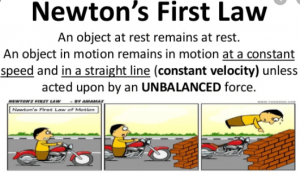Newton’s first law
 Newton’s first law of motion Definition
Newton’s first law of motion Definition
Newton’s 1st law of motion is defined as Every object continues Its state of rest or of uniform motion in a straight line unless it is acted upon by an external force that changes its state of rest or of uniform motion.
Examples of Newton’s first law of motion
- A book lying on a table cannot change its position by itself unless a force is applied to change its
position. - If we push a ball on the ground it should continue Its uniform motion indefinitely but it stops after covering a certain distance. As soon as the ball starts moving a force (force of friction) comes into play which opposes the motion of the ball.
CONCLUSIONS FROM NEWTON’S FIRST LAW
i). Force is an agent that produces or tends to produce a change in the state of rest or uniform motion of an object. .
ii). All the material objects possess the property of opposing any change in their state of rest or of uniform motion.
This property of matter by virtue of which an object resists a change in its state of rest or motion.
is called inertia.
See also: Examples of motion
Law of inertia
Newton’s first law of motion is also called the law of inertia. It is defined as:
“The inability of matter to change its state of rest or of uniform motion is called inertia”.
Explanation:
Mass is the direct measure of inertia Le. the greater the mass of an object the greater will be the inertia because the relatively greater force is needed to change its state.
Examples of law of inertia
1. A small coin is put on a card and placed over a glass. When a card is thrown ay with the finger. The coin drops into the glass.
2. Suppose we are sitting on a stationary bus. If it starts moving suddenly we will feel a jerk in the backward direction. We feel jerk in the backward direction because our body is in contact with the seat of the bus and comes in motion with the motion of the bus while the upper portion of our body remains at rest due to inertia.
Similarly, if the bus is moving and stops suddenly we will feel a jerk in the backward direction.
Read Also: laws of motion
- How many types of motion are there in Physics?
- Equations of motion
- What are the three laws of motion?
- Examples of force
- Branches of Physics
- Difference between distance and displacement
- Newton’s second law of motion
- Newton’s 3rd law